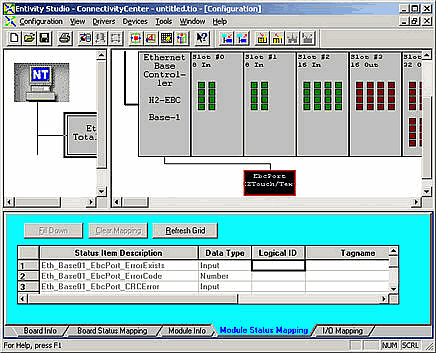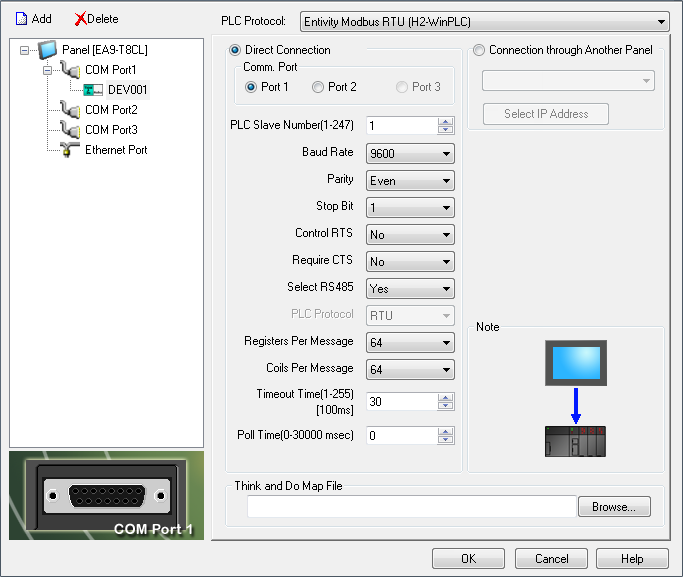Entivity (Think & Do) Modbus RTU (H2-WinPLC) Protocol Setup |
Topic: CM331 |
The following information applies to Entivity (Think & Do) Modbus PLC compatible with C-more Panels. Start with the C-more Panel Setup instructions below. This topic then provides instructions for setup of Entivity WinPLC using LIVE and Studio, and Entivity EBC using LIVE and Studio.
The C-more panel is the master by default.
|
|
Note: Tags for the Think & Do drivers cannot be manually created in the C-more Software. The Map File must be imported into the C-more Project. |
C-more Protocol Manager Settings
- Do one of the following:
- Click the Protocol Manager button on the Home tab
— or — - Click the Protocol Manager button on the Setup tab
— or — - from the Navigation window, click the Function tab, click Setup and then select Protocol Manager.

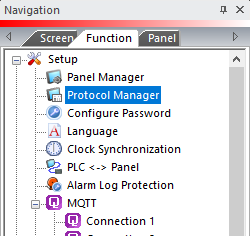
- From the Protocol Manager window, click the Device name on the tree to the left.
- The Device Setup window opens.
- From the PLC Protocol
field, click on the down arrow
 and select
Entivity Modbus RTU
(H2-WinPLC).
and select
Entivity Modbus RTU
(H2-WinPLC).
|
|
Note: You cannot manually create tags for Think & Do drivers in C-more. You must import the map file to the project. When you complete a Build Project and Save in the Think & Do Software, Think & Do creates a folder with the Project Name (in the ThinkNDo\Projects folder). The Map File is in folder ThinkNDo\Projects\ProjectName\RTE Windows CE - Think & Do WinPLC. |
When you select a different PLC Protocol than the one currently in use, the warning Message shown below appears.
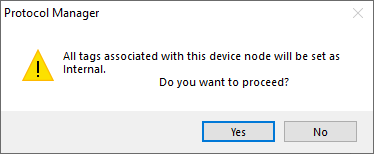
- Click Yes to accept.
Match these settings with Protocol Manager in the C-more Programming Software.
Set up Entivity WinPLC RTU Using Live
This setup information is for the setup of Entivity WinPLC (Modbus TCP/IP Ethernet) using the LIVE software. To see the setup information using the Studio software, see the next subject in this topic.
- Select Windows CE - Think & Do WinPLC from the drop-down.
- Click OK.
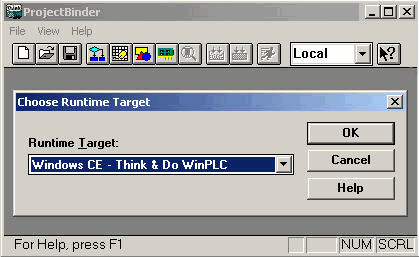
- The Project Binder window shown below opens.
- From the Tools menu, select IOView.
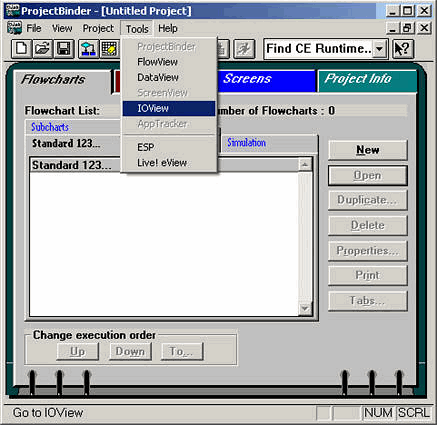
- In the upper left window, select Serial Driver. You may have to scroll down to see it, depending upon the resolution of your PC.
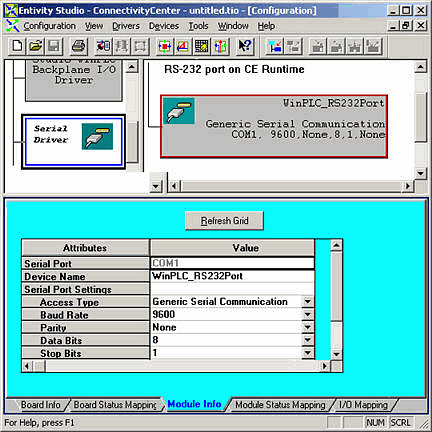
-
In the upper right window, click on the WINPLC RS232 Port.
- Click on the Module Info tab at the bottom to set the serial port.

|
Caution: Record your PLC settings as you change them so that you can reconnect using the same settings later if needed. |
- Change the Access Type to Modbus Slave.
- Match the following parameters to your PLC setup in the C-more Protocol Manager:
- Baud Rate
- Parity
- Stop Bits
-
In the C-more Panel Manager, select PLC Slave Node Number 1.
Set Up Entivity WinPLC RTU Using Studio
This setup information is for Entivity WinPLC RTU PLC using the Studio software. To see the setup information using the LIVE software, see the previous subject in this topic.
-
Click the Connectivity Center icon located under the Project Tab on the Explorer Window.
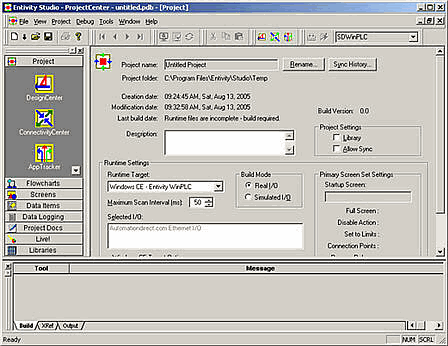
- The Connectivity Center window opens.

-
Choose Serial Driver from the upper left window. You may have to scroll down to see it, depending upon the resolution of your PC.
-
Click on the WINPLC RS232 Port window on the upper right window.
-
Click on Module Info at the bottom to set the serial port.

|
Caution: Record your PLC settings as you change them so that you can reconnect using the same settings later if needed. |
- Change the Access Type to Modbus Slave.
- Match the following parameters to your PLC setup in the C-more Protocol Manager:
- Baud Rate
- Parity
- Stop Bits
- Select PLC Slave Node Number 1 in the C-more Panel Manager.
Set Up Entivity RTU EBC Using LIVE
This setup information is for the setup of an Entivity RTU EBC PLC using the LIVE software. To see the setup information using the Studio software, see the next subject included in this topic.
- In the Choose Runtime Target window, select Windows CE - Think & Do WinPLC from the drop-down list.
- Click OK.

- The Project Binder window shown below opens.
- From the Main menu, click the Tools menu.
- Select IO View.

- Configure your EBC and then select the EBC in the upper left window.
- Click on the Module Info tab at the bottom to set the serial port.
- The EBC Serial Port Settings window shown below opens.

- Tick the Enable Serial Port box.
- Click the Slave Devices Configuration area.
- Click Add.

|
Caution: Record your PLC settings as you change them so that you can reconnect using the same settings later if needed. |
- Choose EZ-Touch/Text in that window.
- Match the following parameters to your PLC setup in the C-more Protocol Manager:
- Baud Rate
- Parity
- Stop Bits
- Use PLC Slave Node Number 1 in the C-more Protocol Manager setting.
- When done, click the OK button to accept all changes.
Set Up Entivity RTU EBC Using Studio
This setup information is for Entivity RTU EBC PLC using the Studio software. To see the setup information using the LIVE software, see the previous subject in this topic.
- In the Entivity Studio - Project Center window, click the Connectivity Center icon located under the Project Tab on the Explorer Window.

- The Connectivity Center window shown below opens.

- Configure your EBC and then select the EBC in the upper left window.
- Click on the Module Info tab at the bottom to set the serial port.
- The EBC Serial Port Settings window shown below opens.

- Click the Enable Serial Port box.
- Click in the Slave Devices Configuration area.
- Click Add.

|
Caution: Record your PLC settings as you change them so that you can reconnect using the same settings later if needed. |
- Select EZ-Touch/Text in that window.
- Match the following parameters to your PLC setup in the C-more Protocol Manager:
- Baud Rate
- Parity
- Stop Bits
- Use PLC Slave Node Number 1 in the C-more Protocol Manager setting.
- When complete, click OK to accept all changes.
When all settings are complete the Studio Connectivity Center should look should look like the image below:
